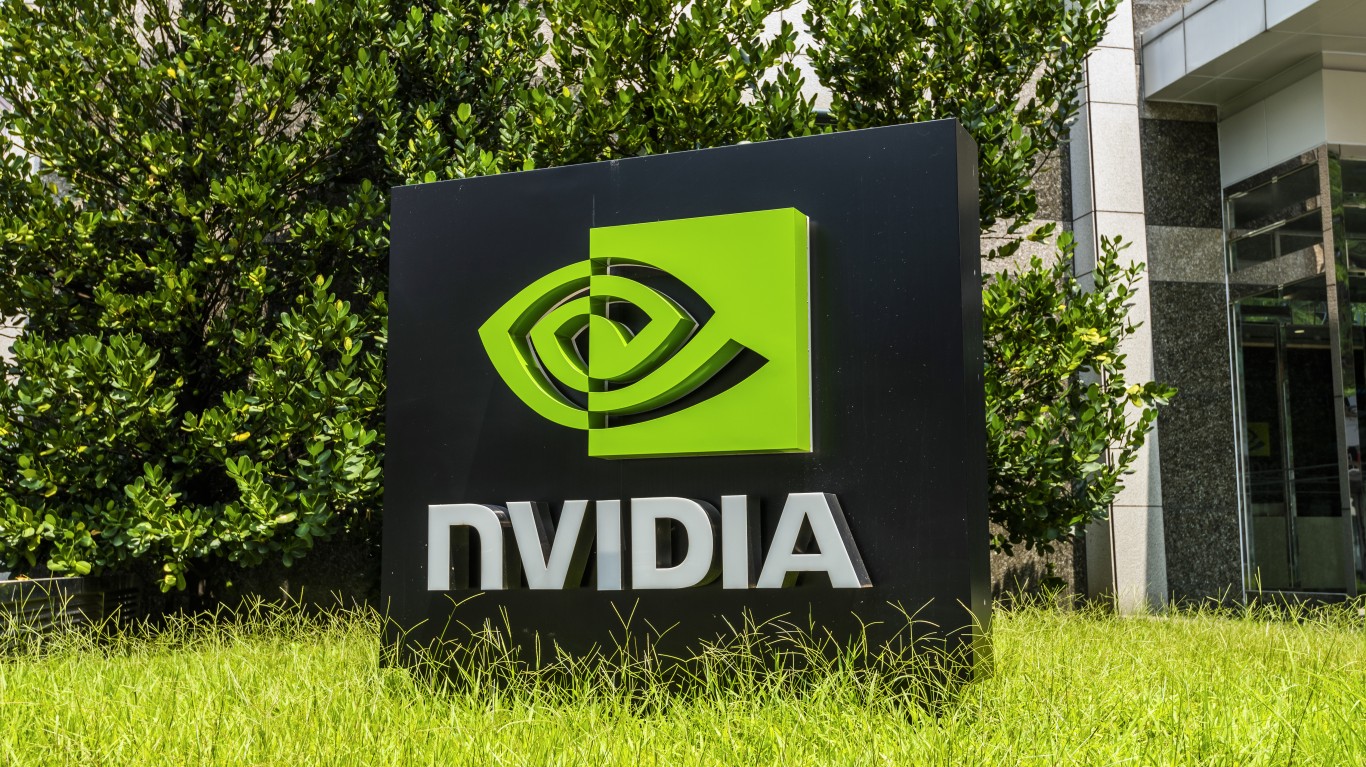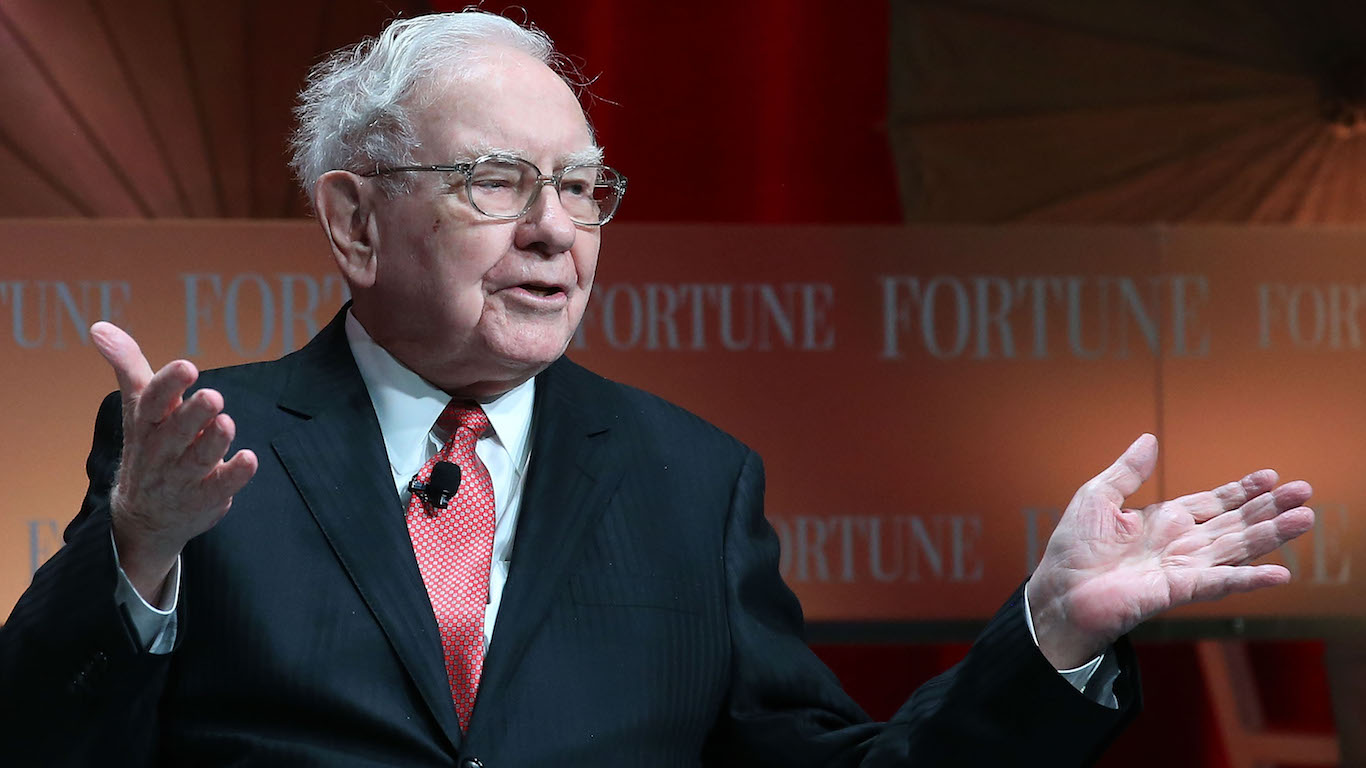Valentine’s Day spending is expected to reach $18.6 billion this year. On average, Americans are expected to spend $130.97 this holiday, up only slightly from $126.03 last year, according to the National Retail Federation.
Even as consumer spending habits change, some products, such as greeting cards and candy, remain Valentine Day staples. Other products, such as jewelry, are less popular and depend on the spending habits of fewer consumers. Companies that make the most on Valentine’s Day typically look to the holiday as vital to their bottom lines.
Click here to see the eight companies that love Valentine’s Day
Many businesses that depend on the holiday sell a product many consumers buy every year. American Greetings Corp. is one of the nation’s largest greeting card companies. It specializes in a product 54% of consumers are expected to buy for their Valentines, according to NRF. The Hershey Company is one of the biggest chocolate and sugar confectionary products manufacturers More than half of all consumers will buy candy for Valentine’s Day, spending a total of $1.66 billion.
Other companies that mark February 14 on their calendar sell high-priced items to fewer consumers. Only 19.7% of consumers plan on buying jewelry from companies such as Tiffany. But the total amount spent is estimated to be $4.4 billion, more than any other good or service for the holiday.
What people buy for Valentine’s Day, and how much they spend, can easily change. Valentine’s Day consumers enjoying an evening out are expected to spend an average of $77 this year. This is up from $66 in 2010, leading to an increase in the total amount spent on restaurants from $3.3 billion in 2010 to to $4 billion 2013. If this happens, high-end restaurant chain brands like Bloomin’ Brands, which owns Outback Steackhouse and Bonefish Grill, will be the beneficiaries.
24/7 Wall St. reviewed the largest publicly traded companies responsible for the most widely-consumed products and services on Valentine’s Day. In some cases, such as Hershey’s, 1-800-Flowers and American Greeting, a majority of the company’s sales are in that product. In others, such as Limited, IAC and Bloomin’ Brands, only part of their sales are in that business, but the company owns the largest brand for the particular product. Bloomin’ Brands owns Bonefish Grill, the largest upscale dining establishment in the country by sales, according to Technomic. We relied on National Retail Federation, for the product categories Americans are likely to buy on Valentine’s Day.
These are the companies that love Valentine’s Day.
1. American Greetings Corp. (NYSE: AM)
> Product: greeting cards
> 12 month sales: $1.75 billion
> 1-year stock performance: 8.1%
> Market cap.: $514 million
Valentine’s Day is the second biggest day for greeting card sales, behind only Christmas, with 145 million cards sent around the country. According to a survey by the National Retail Foundation, more than 54% of people celebrating the holiday plan on buying cards for their sweethearts. American Greetings, headquartered in Cleveland, Ohio, is one of the nation’s leading makers of greeting cards. Among its brands are American Greetings and Papyrus. The company’s inventories are typically largest right before major holidays such as Valentine’s Day, and seasonal cards make up 25% of the company’s sales. American Greetings remains considerably smaller than its privately held competitor, Hallmark Cards. The company is in the midst of a buyout bid from its CEO and chief operating officer, who have offered $17.50 per share.
Also Read: Seven Companies Forced to Change Their Names
2. 1-800-Flowers.com Inc. (NYSE: FLWS)
> Product: flowers
> 12 month sales: $733 million
> 1-year stock performance: 39.7%
> Market cap.: $264 million
1-800-Flowers is an online retailer of flowers and gifts. The company is run by the McCann family, with founder Jim McCann serving as CEO, and son Chris serving as president. Valentine’s Day is one of the company’s “key floral holidays,” as the company describes it. Last year, 1-800-Flowers was criticized by many customers who claimed their Valentine’s flowers either did not arrive on time or arrived damaged. The company actually does more business on Mother’s Day than on Valentine’s Day. Last Valentine’s Day, Jim McCann told CNBC, “apparently there are still more moms than sweethearts.” Nevertheless, the NRF reports that 36.6% of people buying gifts on Valentine’s Day will buy flowers. 1-800-Flowers sold $91.8 million in flowers during its most recent quarter — up 1% from the year before.
3. The Hershey Co. (NYSE: HSY)
> Product: candy
> 12 month sales: $6.64 billion
> 1-year stock performance: 35.6%
> Market cap.: $18.03 billion
The Hershey Company is a manufacturer of a number of well-known chocolate and candy brands, including Hershey’s, Reese’s, Twizzlers and Kit Kat. For Valentine’s Day, Hershey produces heart-shaped boxes in a number of its major brands, as well as heart-shaped versions of its Bliss brand of chocolate. The company has had an especially strong year in 2012 with net sales rising 9.3%. The company also told investors it was expecting sales to grow between 5% and 7% in the 2013 fiscal year and that earnings per share would rise between 10% and 12%. The company’s expansion of core parts of its business and its recent acquisition of Brookside Farms for $13.4 million are expected to drive the company’s growth. Brookside’s main product is fruit dipped in chocolate — perfect for Valentine’s Day. More than half of those surveyed by the NRF expect to buy candy this year for the holiday, with total expected sales on candy at $1.66 billion.
4. Tiffany & Co. (NYSE: TIF)
> Product: jewelry
> 12 month sales: $3.75 billion
> 1-year stock performance: -0.4%
> Market cap.: $8.06 billion
Founded in 1837, Tiffany is known for its blue boxes, silver, engagement ring settings and the film “Breakfast at Tiffany’s.” But some industry observers believe the company has lost appeal with consumers. Tiffany & Co. has struggled with other high-end retailers to attract new customers, and lowered earnings expectations as a result. The company lowered earnings per share guidance from between $3.55 and $3.70 to between $3.20 and $3.40 after adjusting for potential changes in the number of shares. The company also struggled to attract consumers during the holiday season. Valentine’s Day could mark a turning point, with 19.7% of American consumers expected buy jewelry for the holiday, spending more than $4.4 billion overall, according to the NRF.
5. Limited Brands Inc. (NYSE: LTD)
> Product: lingerie, personal care
> 12 month sales: $10.12 billion
> 1-year stock performance: -0.3%
> Market cap.: $12.93 billion
Limited Brands owns Victoria’s Secret, one of the nation’s leading lingerie stores, and Bath & Body Works, a personal care retailer, two the company’s most important brands. Income from core operations for the two brands totaled $215.7 million — $158 million for Victoria’s Secret and $57.7 million for Bath & Body Works — in the most recently announced quarter. The remainder of Limited Brands’ businesses were unprofitable. As of October, there were 1,046 Victoria’s Secret stores in the United States, Canada and the United Kingdom, and a total of 1,650 Bath & Body Works stores. According to the NRF, among Valentine’s Day shoppers, 22.9% will visit a specialty store such as Bath & Body Works, and 7.5% will buy a gift at a specialty clothing store such as Victoria’s Secret for the holiday.
Also Read: America’s Most (and Least) Literate Cities
6. Church & Dwight Co. Inc. (NYSE: CHD)
> Product: prophylactics and personal intimacy
> 12 month sales: $2.92 billion
> 1-year stock performance: 26.5%
> Market cap.: $8.38 billion
Church & Dwight is a consumer goods producer based in Ewing, N.J. In addition to selling household brands such as Oxyclean and Arm & Hammer, the company also manufactures Trojan condoms — the market-leading brand in the United States. On a February 5 earnings call, CFO Matthew Ferrell said, “We are increasing pretty significantly amount of money we are spending on Trojan this year and that will help the entire franchise.” Valentine’s Day, when condom sales are usually at their best, may be one of the first tests of the company’s aggressive approach. Church & Dwight will market its products in New York City by offering free taxi rides during which passengers take a sexual health quiz.
7. IAC/InteractiveCorp (NASDAQ: IACI)
> Product: online dating
> 12 month sales: $771 million
> 1-year stock performance: -4.9%
> Market cap.: $3.79 billion
IAC is an digital media company that owns search engines, news media sites and online dating sites. Among the properties owned by the company are Match.com and OkCupid. In the most recent quarter, IAC’s profits from its dating site operations totaled $62.4 million — a 71% increase from the year before. More than 1.8 million subscribers pay to use the company’s core dating sites, such as Match.com and Chemistry.com. IAC expects its online dating business to continue to grow as the “stigma against online dating [continues] to decline.” The company now offers singles’ events through its dating websites, as well as mobile dating apps such as Tinder. Amarnath Thombre, chief strategy officer for IAC’s Match.com, explained that the period between New Year’s and Valentine’s Day is the busiest business period the site has all year.
Also Read: Eight Companies Ruined by Their Founders
8. Bloomin’ Brands Inc. (NASDAQ: BLMN)
> Product: high-end and upscale restaurants
> 12 month sales: $3.95 billion
> 1-year stock performance: 38.0%
> Market cap.: $2.25 billion
Bloomin’ Brands owns a number of upscale and fine dining restaurants, including Bonefish Grill, Fleming’s Prime Steakhouse & Wine Bar, and Roy’s. With 246 company-owned locations for higher-end customers, Bloomin’ is likely to appeal to the 33% of customers Technomic reports plan on visiting an upscale casual restaurant, or the 24% planning to choose fine dining, for Valentine’s Day. According to the NRF, 36.2% of customers are expected to spend money on an evening out this year, more than in any year since 2009. Bloomin’ has had a strong run since going public in August 2012, its stock rising 37.8% in that time, versus 8.36% for the S&P 500.
Credit Card Companies Are Doing Something Nuts
Credit card companies are at war. The biggest issuers are handing out free rewards and benefits to win the best customers.
It’s possible to find cards paying unlimited 1.5%, 2%, and even more today. That’s free money for qualified borrowers, and the type of thing that would be crazy to pass up. Those rewards can add up to thousands of dollars every year in free money, and include other benefits as well.
We’ve assembled some of the best credit cards for users today. Don’t miss these offers because they won’t be this good forever.
Flywheel Publishing has partnered with CardRatings for our coverage of credit card products. Flywheel Publishing and CardRatings may receive a commission from card issuers.
Thank you for reading! Have some feedback for us?
Contact the 24/7 Wall St. editorial team.



